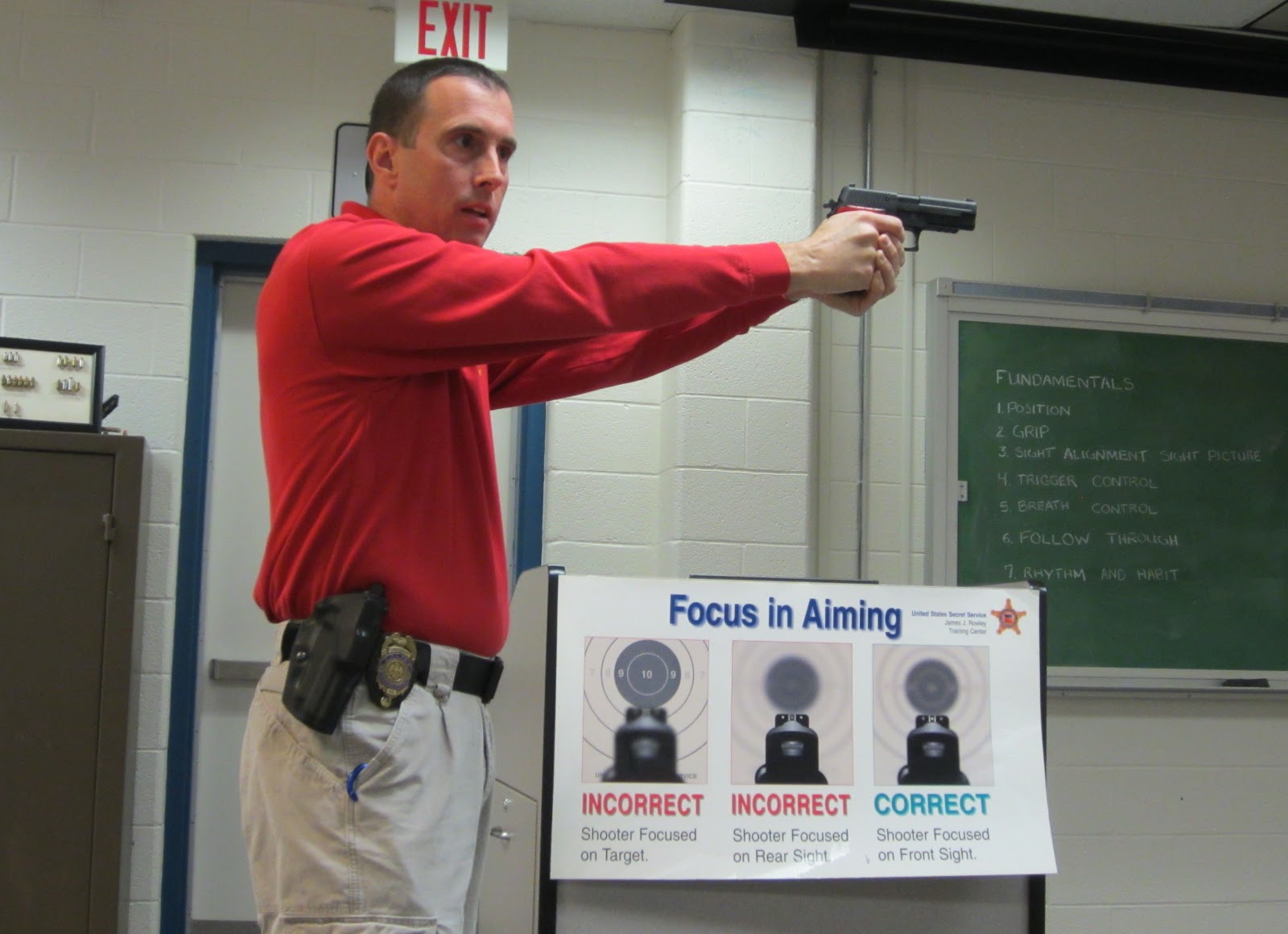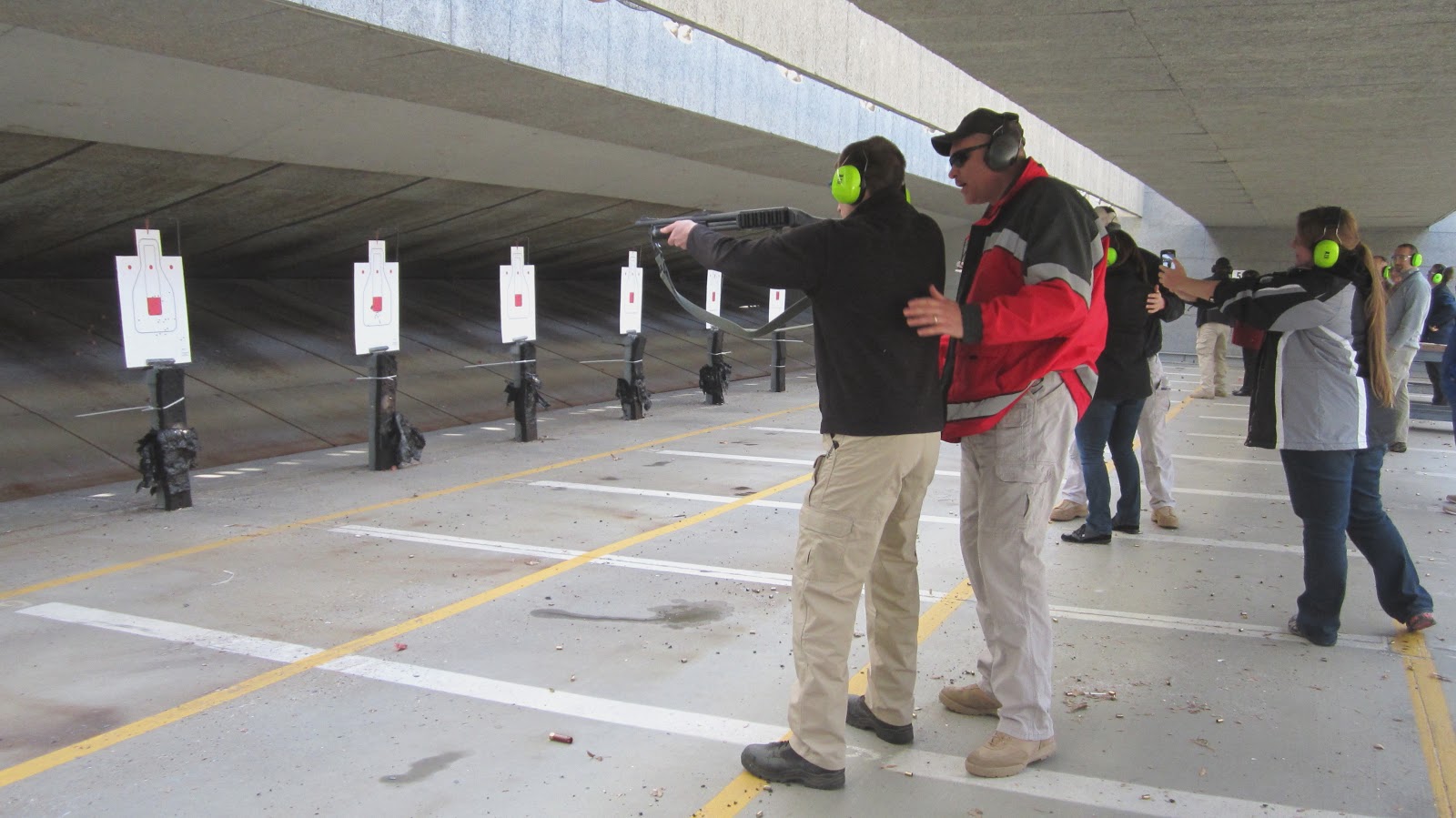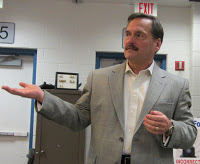Cop school: Shooting and driving
 |
| Lt. Hall demonstrates the correct shooting position. |
At the final session of the Fairfax County Citizens’ Police Academy,
participants had a chance to shoot police guns on the firing range and drive police
cruisers on a training course at the Criminal Justice Academy in
Chantilly. [This report covers a make-up class on Nov. 17 because I was unable
to attend the regular session last spring.]
“Never point a firearm at anyone unless you are ready and
willing to kill that person.” That is one of the key safety rules presented by
Lt. Brian Hall, supervisor of the Fairfax County Police Department’s Firearms
Training Unit.
willing to kill that person.” That is one of the key safety rules presented by
Lt. Brian Hall, supervisor of the Fairfax County Police Department’s Firearms
Training Unit.
Hall explained how to shoot but didn’t get much into when to
shoot. He did say, however, that a police officer is justified in using a
firearm “if you feel your life is in danger or there’s a huge threat of
physical injury.”
shoot. He did say, however, that a police officer is justified in using a
firearm “if you feel your life is in danger or there’s a huge threat of
physical injury.”
 |
| Citizens’ Police Academy participants practice on the firing range. |
Other safety rules stressed by Hall:
- Treat all weapons as if they were loaded.
- Keep your finger off the trigger until you are
ready to fire. - Be sure of your target and what is beyond.
Regarding that last rule, Hall described an incident earlier
this year involving an officer “who was more than justified in shooting” a man
who was coming at him with a hammer and banging it on the hood of the police
cruiser. The officer didn’t shoot, though, because there was a playground behind
the assailant.
this year involving an officer “who was more than justified in shooting” a man
who was coming at him with a hammer and banging it on the hood of the police
cruiser. The officer didn’t shoot, though, because there was a playground behind
the assailant.
The handguns issued to officers are .40-caliber Sig Sauer
P226 or P229 pistols. They can shoot accurately at 100 yards, Hall said. The shotguns are 12-gauge Remington 870s. They can use a buckshot
round consisting of a one-ounce piece of lead (a slug round) or a “bean sock
round,” which causes less damage and is usually used in the type of situation
where a suspect is threatening an officer with a knife.
P226 or P229 pistols. They can shoot accurately at 100 yards, Hall said. The shotguns are 12-gauge Remington 870s. They can use a buckshot
round consisting of a one-ounce piece of lead (a slug round) or a “bean sock
round,” which causes less damage and is usually used in the type of situation
where a suspect is threatening an officer with a knife.
The SWAT team uses a .223-caliber LWRC rifle, which can fire
a round that “can go a very long way and do a lot of damage,” Hall said. That
weapon would come in handy when they’re involved in a stand-off and need to
shoot through a door, for example. Officers have to be approved by their
supervisors and complete a 50-hour training block before they are issued one of
those rifles.
a round that “can go a very long way and do a lot of damage,” Hall said. That
weapon would come in handy when they’re involved in a stand-off and need to
shoot through a door, for example. Officers have to be approved by their
supervisors and complete a 50-hour training block before they are issued one of
those rifles.
 |
| The obstacle course where cops learn to drive. |
The training center’s Emergency Vehicle Operation Center has
an obstacle course where police recruits learn how to chase a suspect while
maneuvering through traffic and sharp turns.
an obstacle course where police recruits learn how to chase a suspect while
maneuvering through traffic and sharp turns.
Master Police Officer Thomas Beckman said when he trains recruits,
he starts with the basics and focuses on safety. And by basics, he means how to get into a car
and how to do “shuffle steering” (both hands on the outside of the steering
wheel; left hand on the left side, right hand on the right) so your wrist
doesn’t get broken if the air bag activates. Always keep the doors locked, he said,
because you could fly out of a car if there’s an accident even if you’re
wearing a seatbelt. And keep the windows all the way up or down to avoid
getting cut by the window edge in a crash.
he starts with the basics and focuses on safety. And by basics, he means how to get into a car
and how to do “shuffle steering” (both hands on the outside of the steering
wheel; left hand on the left side, right hand on the right) so your wrist
doesn’t get broken if the air bag activates. Always keep the doors locked, he said,
because you could fly out of a car if there’s an accident even if you’re
wearing a seatbelt. And keep the windows all the way up or down to avoid
getting cut by the window edge in a crash.
 |
| Dodging cones. |
When the participants in the citizen’s police academy
prepared to drive a cruiser on the course, Beckman told us to practice “ocular
driving—your hands take you where your eyes are looking.”
prepared to drive a cruiser on the course, Beckman told us to practice “ocular
driving—your hands take you where your eyes are looking.”
Recruits have to pass a driving test that includes precision
driving through a cone course, parallel parking, and backing into a narrow
space. Anyone who fails three times is dismissed from the academy. Those who
pass have three chances to pass another test where they have to negotiate an
obstacle course with simulated street conditions, including stoplights, stop
signs, traffic, and radio traffic causing distractions. The final test for the
recruits is a nighttime, simulated high-speed pursuit of a “rabbit car” with
lots of obstacles and distractions.
driving through a cone course, parallel parking, and backing into a narrow
space. Anyone who fails three times is dismissed from the academy. Those who
pass have three chances to pass another test where they have to negotiate an
obstacle course with simulated street conditions, including stoplights, stop
signs, traffic, and radio traffic causing distractions. The final test for the
recruits is a nighttime, simulated high-speed pursuit of a “rabbit car” with
lots of obstacles and distractions.
“High-speed pursuit is one of the scariest things you will
ever do as a police officer, especially with the traffic in Northern Virginia,”
Beckman said.
ever do as a police officer, especially with the traffic in Northern Virginia,”
Beckman said.
The Fairfax County Police Department is getting ready to
pick a new vehicle to replace the Crown Victoria, which Ford isn’t making any more.
The department will select either the Chevy Caprice or Ford Interceptor,
Beckman said.
pick a new vehicle to replace the Crown Victoria, which Ford isn’t making any more.
The department will select either the Chevy Caprice or Ford Interceptor,
Beckman said.
 |
| Rohrer |
The training academy uses cars donated by the public as
rabbit cars. When the driver training unit is through with the donor cars, they
go to the bomb squad or Fire Department for more training. Donors get a tax credit
for the full Blue Book value of their car. If you’re interested in donating a
vehicle, contact MPO Beckman, 703/818-1924, ext. 200.
rabbit cars. When the driver training unit is through with the donor cars, they
go to the bomb squad or Fire Department for more training. Donors get a tax credit
for the full Blue Book value of their car. If you’re interested in donating a
vehicle, contact MPO Beckman, 703/818-1924, ext. 200.
At the end of the class, Citizens Police Academy participants
were given certificates for completing the academy in a ceremony presided over
by Acting Police Chief Lt. Col James Morris, Deputy Police Chief Lt. Col. Ed Roessler
Jr., and former Police Chief David Rohrer, who was named deputy county
executive for public safety in September.
were given certificates for completing the academy in a ceremony presided over
by Acting Police Chief Lt. Col James Morris, Deputy Police Chief Lt. Col. Ed Roessler
Jr., and former Police Chief David Rohrer, who was named deputy county
executive for public safety in September.
 |
| My target. |
“We are blessed to have such a caring and engaged community,”
said Rohrer, who joined the police department in 1980 and is still adjusting to
a job that doesn’t require a uniform.
said Rohrer, who joined the police department in 1980 and is still adjusting to
a job that doesn’t require a uniform.
Morris urged the participants to stay involved with the Police Department by jointing the Citizens Police Academy Alumni Association
and attending the citizen’s advisory committee (CAC) meetings at their local police station. The public is
welcome to attend the Mason Police District CAC meetings on the first Tuesday
of the month, 7:30 p.m., at the Mason Government Center.
and attending the citizen’s advisory committee (CAC) meetings at their local police station. The public is
welcome to attend the Mason Police District CAC meetings on the first Tuesday
of the month, 7:30 p.m., at the Mason Government Center.


Very interesting series of posts, although the headline is what caught my eye. I was impressed that cop school had a class on Shooting and Driving, and was wondering if they also had Shooting and Driving While Wearing Sunglasses At Night, Walking Away from Explosions In Slow Motion, and How To Not Play By The Rules.
Please note the Dec. CAC Mtg. this coming Tues., Dec. 4th, will be the annual Holiday Pot Luck and will start at 7 pm instead of the usual 7:30 pm. including an abbreviated business meeting. Please bring a food item to share. The next regular CAC Mtg. will be on Tues., Feb. 5. There is no Mtg. in January as the first Tues. in Jan. is New Year's Day. Public is welcome to attend!